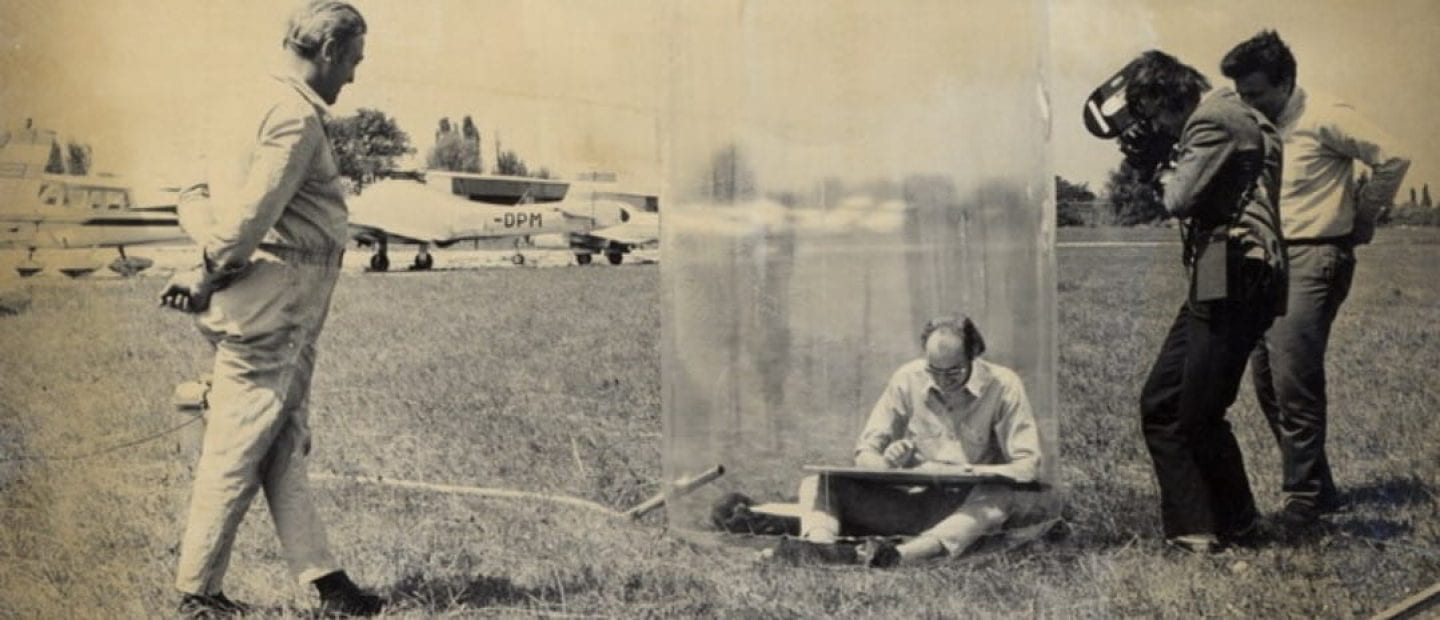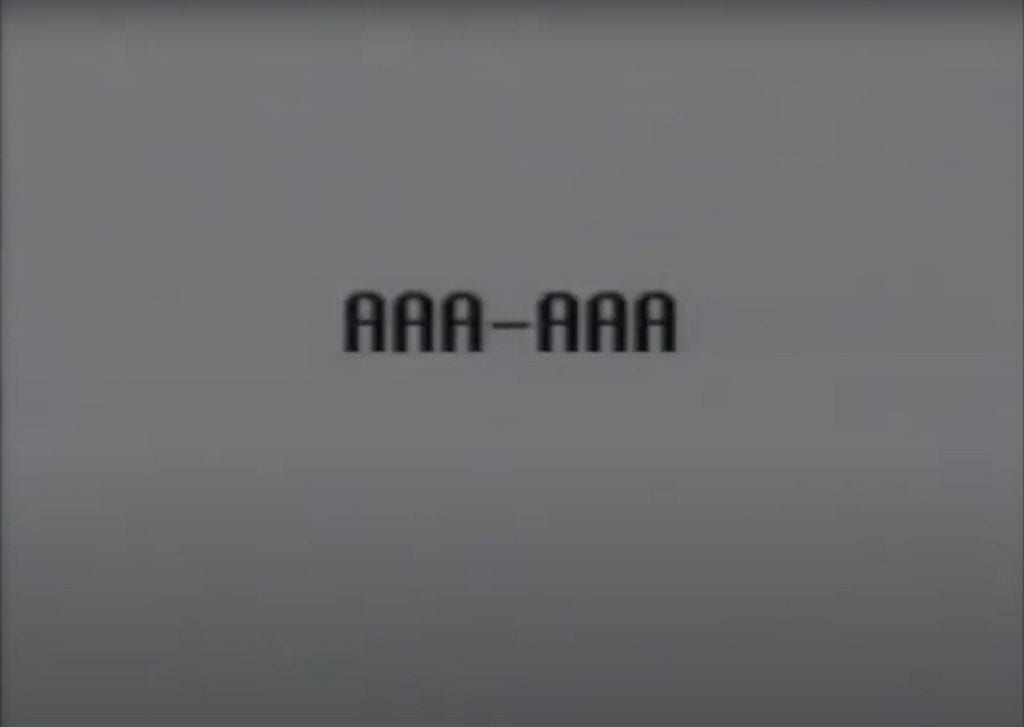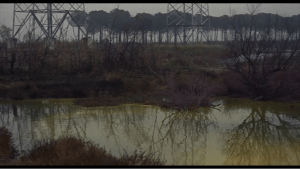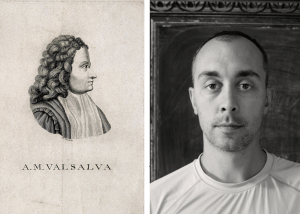AAA-AAA: Breath as Object, Breath as Relation
By: Michael Stablein, Jr.
Click here for video recording of my presentation
In the title to Marina Abramović and Ulay’s 1978 work of performance, AAA-AAA, we are already presented with a kind of score—a description of and instruction for the performance it precedes. Here, for example, we might think of the title as standing in for the bodies of the performers: Ulay on the left, Abramović on the right, tethered to and kept separate by a hyphen. Alternately, if we take into account the rightward slant of the italics demanded by a title, we might also read a set of instructions for each performer. Each iteration of AAA denoting a single, prolonged vocal expulsion, the hyphen demarcating a requisite breath, before another expulsion of the voice, AAA. Taking these two readings in tandem, Abramović and Ulay’s title presents a kind of diagram for not only the performance but for us here as a larger concept of encounter between bodies, an encounter facilitated by voice and by breath.
The infamous Serbian conceptual artist and self-proclaimed “grandmother of performance art,” Marina Abramović, collaborated with German performance artist, Ulay (born Uwe Laysiepen), from 1976 to 1988. Together they produced a series of “relation works” (such as this one) that attempted the collapse of that very collaboration into what they termed a single “hermaphroditic state of being” or “death self.” Here I want to introduce a few examples of those relation works, ones that precede and inform the performance, AAA-AAA. In their 1976 work, Relation in Space, Abramović and Ulay perform naked, repeatedly walking into each other—slamming into each other—with increasing violence, eventually sending Abramović to the floor. In the following year they performed Relation in Time, sitting back to back and tied to the other by their hair for sixteen hours before allowing an audience to enter and prolong the work to a breaking point. And in that same year, 1977, they performed Breathing In, Breathing Out, by locking mouths and quite literally breathing the same breath—one breath?—in and out between them until they could no longer maintain the performance. This last work poses a compelling comparison as the predecessor to AAA-AAA in their collaborative repertoire. As we heard in the previous clip, Breathing In, Breathing Out also entails a vocal exchange, albeit subtle. A kind of internal AAA seems to accompany the breath that moves between the performers or rather is deployed by each performer in order to volley that self-same breath back and forth.
Lastly, before returning to the performance at hand, I wanted to also call our attention to a prior solo work of performance by Abramović in 1976, Freeing the Voice. As a kind of counterpoint to the relation works, here she screams for forty-five minutes—until hoarse, until she can scream no longer—but she performs on film without Ulay, and without a clear object of address. Performing essentially the same tenets of AAA-AAA but without Ulay and thus without the successful production of “a continuous vocal sound,” this work more explicitly foregrounds the question of endurance and the limits of the individual body (a theme resonant with much of Abramović’s career).
Returning to AAA-AAA, the film recording of the private performance opens not only with this title-cum-score but with an actual score (description-as-instruction) spoken in voiceover by Marina Abramović herself:
We are facing each other, both producing a continuous vocal sound. We slowly build up the tension, our faces coming closer together, until we are screaming into each other’s open mouths.
The film then reveals just that: Ulay (on the left) and Abramović (on the right) facing each other in profile. They then take a deliberate inhalation of breath in unison before exhaling together, and with that exhalation a sustained pitch not yet quite resembling a scream but certainly that aforementioned “continuous vocal sound.” And yet, oddly, they maintain synchronous breaks for breath—at least initially—and with that they blatantly disrupt the desired continuity of vocal sound. Rather than recover their breath independent of the other by taking turns, the breaks for breath are initially taken in deliberate unison. As Abramović and Ulay “slowly build up the tension” the voice falters—or rather points to a faltering body. First Ulay and then, much later, Abramović. Once Ulay’s voice begins to falter he falls out of step—out of breath—with Abramović’s seemingly indomitable vocal sequence. In the buildup, what initially seems no more than a sustained vocal pitch interrupted by a collective gathering of breath progressively becomes a proper scream and a cooperatively continuous one at that. One loaded with affect, producing and eliciting exhaustion and intention. But it is that requirement of breath—rather than the foregrounded vocal development of a scream—to which I would like to call our attention here.
In “Breath and Precarity,” Nathaniel Mackey, in his description of the “pneumatic turn” of New American Poetry, tells us that
When breath becomes an object of attention, no longer unremarked on, no longer taken for granted, no longer an uninspected given, anxiety is also in the air […] breathing attends anxiety (Mackey, 5).
Breath, typically that unremarked on variable, sustains our very lives. We take it for granted precisely to avoid an anxious encounter with our very precarious and variable relationship to it. And, for our purposes here, it remains uninspected in order to avoid the ways that our equally anxious encounters with others are necessitated by breath, instantiated by shared breath—attended by a breathing in, breathing out. In Ulay and Abramović’s performance, breath similarly emerges as an object. As I mentioned before, it quite theatrically begins the performance itself and as the performance unfolds, breath returns (first in unison, and then individually) to mark the passage of time, the corporeal needs of the performers, and as a measure of each performer’s success or failure in the vocal showdown. Following Mackey, “the involuntary is rendered deliberate, [then] labored, in which breath is belabored, made strange” (8, italics mine). Furthermore, breath does significant work here formally in both its support of the voice and in its very opposition to it.
As is quite obvious, each deep inhalation of breath provides the diaphragmatic support for the successive sound/scream—what Mladen Dolar would call “a miniature drama, a contest” that attends “every spoken utterance” (Dolar, 72). But at one and the same time, it likewise undercuts that very opposition as merely a contest between Abramović and Ulay, thus calling attention to a shared relation that serves as its structure. As Dolar suggests in A Voice and Nothing More, “the voice cuts both ways: as an authority over the Other and as an exposure to the Other, an appeal, a plea, an attempt to bend the Other” (Dolar, 80-81). And yet, Dolar does not directly attend to breath, instead reserving the relation between body and language—and thus with body and other—as primarily a vocal one. Here, Abramović and Ulay—by breathing in unison, then breathing individually, and eventually by struggling to catch enough breath to even continue—draw us beyond the voice and its capacity. In fact, they draw us to that which provides for vocal capaciousness itself (or lack thereof)—they draw us to breath.
As mentioned, they begin the performance together, as collaborators, working together to accomplish the score. Attending to both their own capacity and the capacity of their partner, they jointly break the vocal emission to draw breath. Each inhalation is performed with such deliberation and necessity they physically swing away from each other, almost exiting the frame of the film, before swinging back together—closer now than before—with each downbeat of vocal exhalation. But still, with each tandem breath they also seem to inhale the very space between them, sucking in and slowly but surely displacing the gap that separates them from each other. Dolar again:
It cuts directly into the interior, so much so that the very status of the exterior becomes uncertain, and it directly discloses the interior, so much so that the very supposition of an interior depends on the voice” (81).
Here again Dolar is speaking of the voice alone, but following the trajectory of Ulay and Abramović’s performance, it is breath—on its every inhalation—that cuts in and carves out the landscape of their interiors. And the landscape of their shared exterior erodes with each and every breath. By the end, the performance could almost segue into their earlier work, Breathing In, Breathing Out. Locking mouths, they could fully eliminate the contested space between them—what Dolar calls the overlapping and extimate space that belongs to both of them and neither of them (81). They could close and secure a circuit of breath and voice, if only Ulay could keep up.
In the end, Abramović defeats him. Ulay, physically and vocally spent, retreats out of the frame but Abramović continues. Breathing in and breathing in the empty space of the frame, she emits seven more screams for good measure before retreating as well. But those last solitary screams bear a noticeably changed affect. Something melancholic, yearning, some narrative almost like loss, emerges from the empty space. She, like Ulay, is spent and her breathing is shallow and ragged. Shallow like for lack of air—Ulay’s?—ragged like a piece of something torn away. Borrowing from and adulterating Dolar: “One is too exposed to the [breath] and the [breath] exposes too much, one incorporates and one expels too much” (81).
At the start I called attention to the title of the performance, AAA-AAA, as a kind of score. I wish to conclude by meditating on that hyphen that both severs and tethers those two titular utterances. That hyphen as sign for performed breath, read as both instruction and description (performative and constative) likewise signifies the dual structure of breath I marshaled between Nathaniel Mackey and Mladen Dolar. On one hand, hyphen as breath and breath as object. And on the other, hyphen as breath and breath as relation. In the third chapter of his book, Dolar nods to the ubiquity of the Lacanian diagram with one of his own: “the circle of language and the circle of the body, the intersection being extimate to both”—“what language and the body have in common is the voice, but the voice is part neither of language nor of the body” (73).
Following from this conception, I want to leave us with a half-baked diagram of my own. Where do we place breath in the diagram of extimate space between bodies and language? Voice is clearly inextricable from breath but, for Dolar, is breath inextricably tethered to voice? Is the voice always somehow present in the breath like the murmuring AAA still present in the performance of Breathing In, Breathing Out—“breath being the ‘voiceless voice,’ the zero point of vocal emission” (71)? Moreover, does breath only engage language on the bridge of the voice or can breath and language meet elsewhere without it? What languages are made possible by breath acknowledged as its own object of attention?
WORKS CITED:
- AAA-AAA. Marina Abramović and Ulay, 1978. https://www.youtube.com/watch?v=RGfbSQ7WseM&feature=emb_logo.
- Breathing In, Breathing Out. Marina Abramović and Ulay, 1977. https://www.youtube.com/watch?v=rWixdA2xTSs.
- Dolar, Mladen. A Voice and Nothing More. Cambridge, MA: The MIT Press, 2006.
- Freeing the Voice. Marina Abramović, 1976. https://www.youtube.com/watch?v=rWixdA2xTSs.
- Kim, Myung Mi, Cristanne Miller, and Nathaniel Mackey. “Breath and Precarity.” In Poetics and Precarity. Albany, NY: State University of New York Press, 2018.
- Relation in Space. Marina Abramović and Ulay, 1976. https://www.youtube.com/watch?v=L3aNbDMVoXc.
- Relation in Time. Marina Abramović and Ulay, 1977. https://www.youtube.com/watch?v=1sRSoGAc3H0.











Leave a Reply
You must be logged in to post a comment.